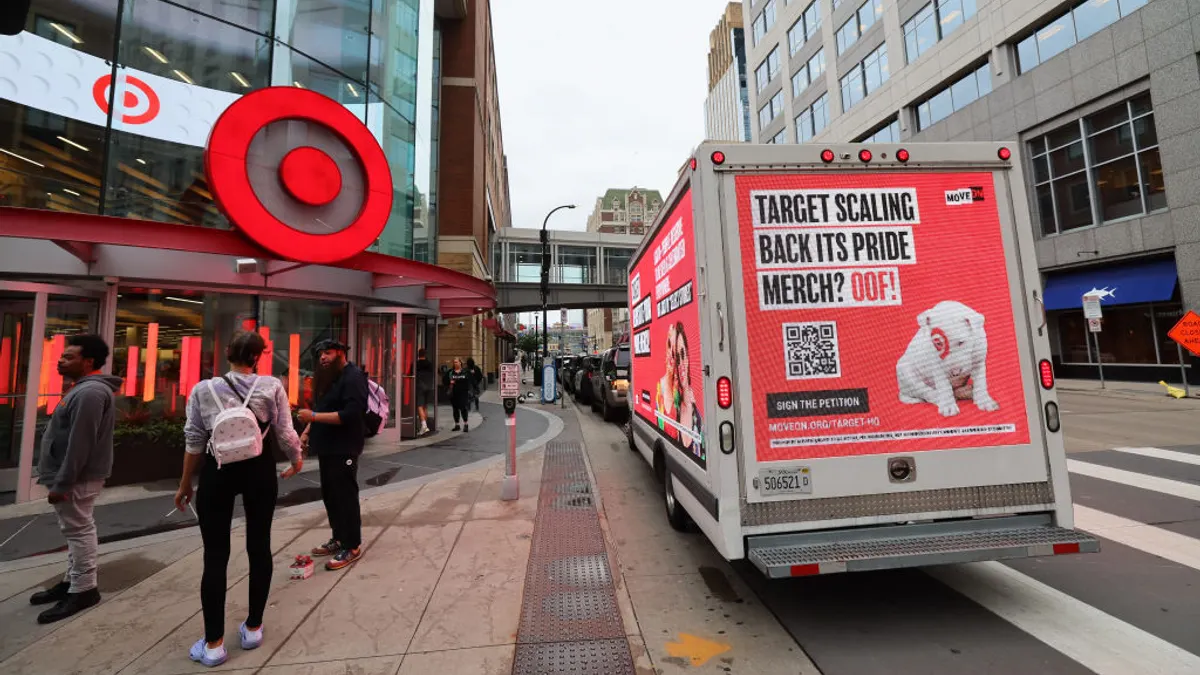The original premise of Victoria's Secret's disruption of the American lingerie market sprang from a familiar source: frustration. Founder Roy Larson Raymond, shopping for his wife in the 1960s, could find only dowdy underwear at department stores or pin-up/bondage-wear from Frederick's of Hollywood (founded decades before by the inventor of the original push-up bra).
In 1977, he turned that vexation into a business, launching Victoria's Secret in San Francisco as a specialty retailer with dimly lit stores staffed by employees who helped regular women buy alluring underthings. But it was The Limited founder Les Wexner, widely seen as one of America's foremost retail visionaries, who after acquiring the brand's five stores and catalog in 1982 from Raymond for $1 million, transformed it into the lacy, racy mass market alternative it is today.
It's been a blockbuster: Last year, as the largest business in Wexner's L Brands stable, Victoria's Secret racked up revenue of $7.4 billion. "If you were couture, you couldn’t compete with Victoria’s Secret," said Lee Peterson, EVP of brand strategy and design at design firm WD Partners, who worked with Wexner at The Limited in the 1980s. "When you think about a brand’s soul, theirs is 'sexy and glamorous.' They came up with that catalog and the idea of sexy as an attainable girl. Then Les applied his merchandising genius with 'by one get one free.'"
But slips are showing. Last year's sales were down from $7.8 billion in 2016. In the most recent quarter, Victoria's Secret same-store sales rose 1% after a 14% drop in the same period a year ago, and after falling 1% in the crucial holiday quarter. (Neither L Brands nor Victoria's Secret immediately answered Retail Dive's questions for this story.)
"Victoria's Secret's issue centers around one thing — they’ve been unable to move the premise of the brand off of what’s been successful," Peterson told Retail Dive in an interview. "It's the Mike Jeffries syndrome — he was at Abercrombie for 20 years and what happened probably happens to rock stars. You're so big, everyone’s telling you what you want to hear and you stick to your guns when in fact you need to evolve."
Not that kind of 'push-up'
The consumer, meanwhile, is definitely evolving.
To increasingly more women of all body types, a "push-up" is more likely something to do at the gym than keep in their lingerie drawer, and that's hurting sales. In the second half of last year, push-up bra sellouts declined 45% year-over-year, while sports bras sales grew 39%, according to data from retail analytics company Edited. Softlines have strengthened even further as part of a larger trend in 2018: New arrivals of bralettes grew 138% in the first quarter of this year compared to the same period last year.
"What's interesting is that Victoria's Secret still seems to be missing that, having shrunk their own triangle-style assortment by half, as well as having fewer sports bras in stock today than one year ago," Edited Retail Analysis and Insights Director Katie Smith told Retail Dive in an email. "They've also grown the average price from $30.01 on bras to $34.16, which won't help in the competitive market squeezed by fast fashion retailers' lingerie lines."
The brand simply hasn't embraced the new reality — sexy is out, comfort and/or performance are in — very swiftly, or broadly, according to Jane Hali, CEO of investment research firm Jane Hali & Associates. To some extent, their merchandising takes the trend into account, but the marketing lags. The brand offers a new stretch cotton collection, for example, labeled “Cotton, Sexy, Cool.”
"We know that cotton is comfortable, soft and cool against the skin, but I’m not sure the customer would classify it as 'sexy,'" Hali told Retail Dive in an email. "The whole message and mystique of VS has been 'sexy.' That is their legacy, what they are known for. But generations Y and Z, their customers, are the same ones buying 'Dad' sneakers, streetwear and activewear."
#NotMe
A female empowerment wave emerging from the #MeToo movement may not be helpful to Victoria's Secret.
After reaching a high "Buzz score" of 31 among shoppers aged 18-49 in early 2016, the brand has tumbled to 23, according to the latest data from the YouGov BrandIndex, which measures whether consumers hear positive or negative things about brands from friends and family, the news and advertising. The number of women in that demographic who report buying from the brand is also at its lowest since 2013, according to YouGov’s survey.
In an era when even Miss America has dropped its swimsuit competition, declaring this month, "We are no longer a pageant" and hashtagging the move #byebyebikini, Victoria's Secret is still producing its famous televised fashion extravaganza, featuring underwear-clad top models outfitted with wings, known as "angels." Last year the show aired about a month after multiple sexual harassment reports came out against film producer Harvey Weinstein. Ratings suffered a new low, falling 30% from the previous year, and the timing may have been a factor, according to YouGov researcher Paul Hiebert.
"The fashion show. Diamond-crusted bras at Christmas. The angel wings. There was a glamour pedestal you could put Victoria's Secret on," Peterson said. "But it's same same same same. It's the rock star playing that same B chord."
YouGov’s report wasn’t all bad for the brand: In a statistic that shows how diverse female empowerment actually is, more U.S. women aged 18-49 say they'd be more proud than embarrassed to work for Victoria's Secret, and a third expressed an openness to shopping there. The company remains strong in other measures, too. Victoria’s Secret was the top retail brand on social media, for example, receiving more than 352 million cross-platform actions (likes, comments, retweets, etc., on Facebook, Twitter and Instagram), according to social media analytics firm Shareablee's most recent State of Social report.
Sibling rivalry
In 2002, Victoria's Secret launched Pink as a product line aimed at girls and younger women, and it's since morphed into a separate brand with its own standalone stores that last year generated more than $3 billion in sales, according to Fitch. Pink sells less seductive, sportier merchandise more in tune with current consumer attitudes, bolstered by a strong sleepwear and beauty assortment, according to Jane Hali & Associates.
They've stepped on that success by ending swimwear sales, say both Hali and Peterson. "This will negatively impact comps as they lap the spring '18 result in spring of '19," Hali warned. L Brands executives reportedly defended the move, and their continued dedication to a vast physical footprint for Victoria's Secret, at their recent shareholders meeting. It's a curious forfeit of sales for an underwear company, considering that the design and manufacture of swimwear is so similar, Peterson said.
But Pink, longer term, may present an even bigger problem for Victoria's Secret because it's poised to undermine the flagship, Peterson says. Such sub-brands, often priced lower, are developed to dominate a niche and, in Pink's case, serve as a gateway to the higher-priced sibling. Trouble is, that migration mostly doesn't occur.
"It reminds me of when Les Wexner said that Limited Express was going to be for 'young people' and that The Limited was going to sell to 'young professionals.' Limited Express was more fun, the music was better, and that was the end of The Limited," Peterson said, noting that such moves have had unintended consequences at several retailers. (Neither banner is owned by Wexner's company anymore; Limited Express is now "Express," and The Limited went bankrupt last year.) "Look at Hollister and Abercrombie & Fitch. They said 'Let’s give Hollister fashion and price.' Subsequent death knell for A&F. Old Navy is cannibalizing the Gap in a similar fashion."
That's already emerging as a problem for Victoria’s Secret and Pink, he said. "Eventually it seems like the consumer gets over that brand factor. You thought Gap was the best, The Limited was the best. But the generation that loved that brand moves on. Meanwhile, their kids might have started with Pink, but they don’t have that devotion to Victoria's Secret. Then everybody just descends to the price."
Cold comfort
Victoria's Secret may not be seizing the opportunity proffered by the new paradigm in lingerie fashion, but others are.
Shoppers can find pretty, comfortable and performance-athletic underwear at plenty of other brands, including American Eagle's Aerie, Gap's new Love brand and J.Crew's new intimates line, along with ranges from online upstarts like Everlane, Adore Me, True & Co, Lively and Thirdlove. Stitch Fix now has an add-on for its women's boxes called Stitch Fix Extras, a curated collection of camisoles, shapewear, underwear, tights, bralettes, bras and socks featuring brands like Wacoal, Free People and Hanky Panky as well as the company's private label, Everyday by Stitch Fix. Not to mention the high-performing and often stylish items available from athleisure retailers like Lululemon and Gap's Athleta.
"The dark store environment, the conspicuous sexuality of the offer and the brash marketing are increasingly out of step with what modern consumers want," GlobalData Retail Managing Director Neil Saunders said in comments emailed to Retail Dive. "This is one of the reasons why more subtle brands like Aerie have resonated with consumers and have delivered strong growth. As much as we appreciate that the heritage of Victoria's Secret is hard to change, more action is needed if the brand is to recover."
It's a tall order because the whole proposition needs a lift, according to experts. "It’s a brand hole — it’s not just product — and it’s deep," Peterson said, noting that the company's endurance could be making executives hesitate. "It’s hard to criticize it because these guys have had 25 years of crazy sales. They’re still doing millions of dollars a month, so there are customers who love what they’re doing."
Further complicating that is the fact that the brand's legacy approach is resonating in China. "China is a different story," Hali said. "This is where localization comes in. That female customer is newly empowered, [so] sexy works better there. ... But in JHA’s monthly research analysis of assortments in the U.S., U.K. and China we find the products across geographies to be exactly the same."
The necessary adjustments are dictated more by time than geography, though. Many brands triumph only as part of a zeitgeist that defines a cultural moment, and those come and go, Peterson said. For Victoria's Secret, it looks to be over.
"This weird refusal to change in the fashion business comes from thinking that, just because you fit into a zeitgeist, it’ll last forever," he said. "But we’re now on a rocket ship turning 90 degrees left, and we’re going to go this way for a long time. It’s a lot different generation, they think differently and don’t want to be a glamazon or an angel. Victoria's Secret has a lot of work to do, they really do."




















